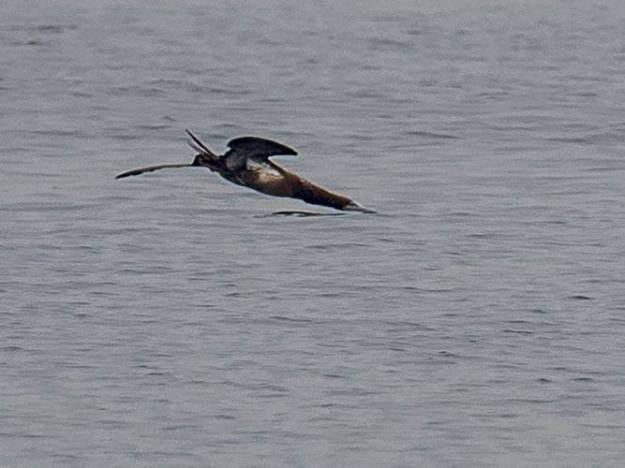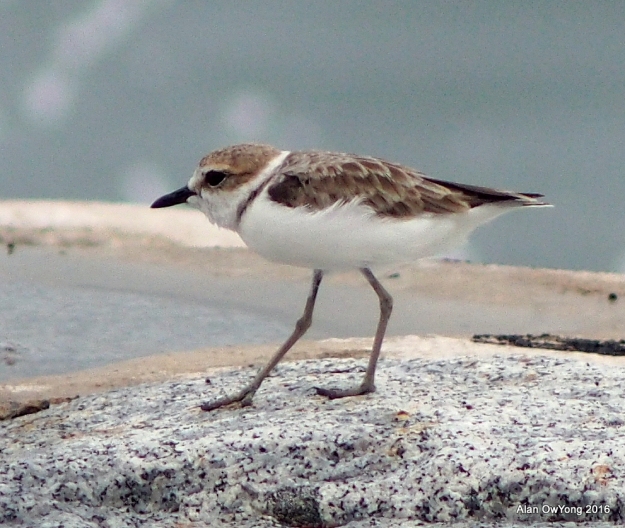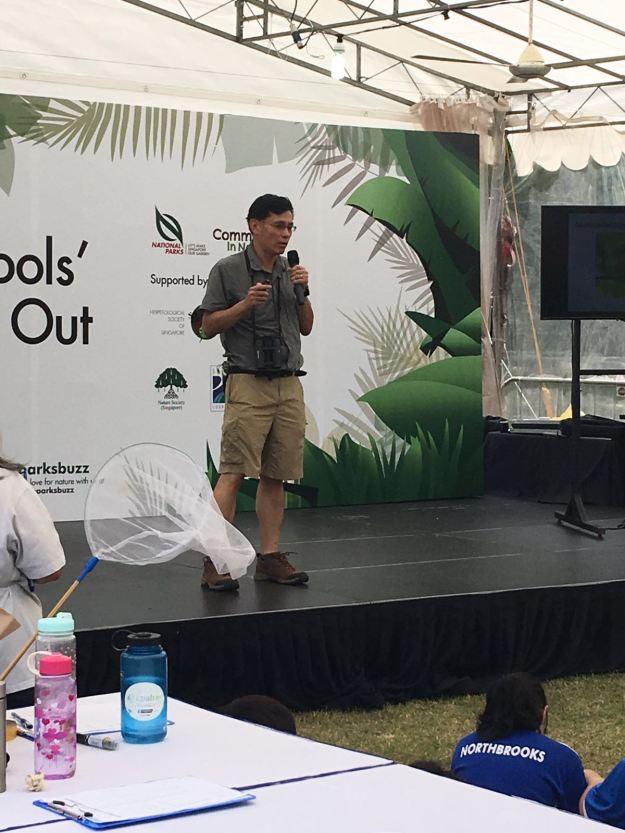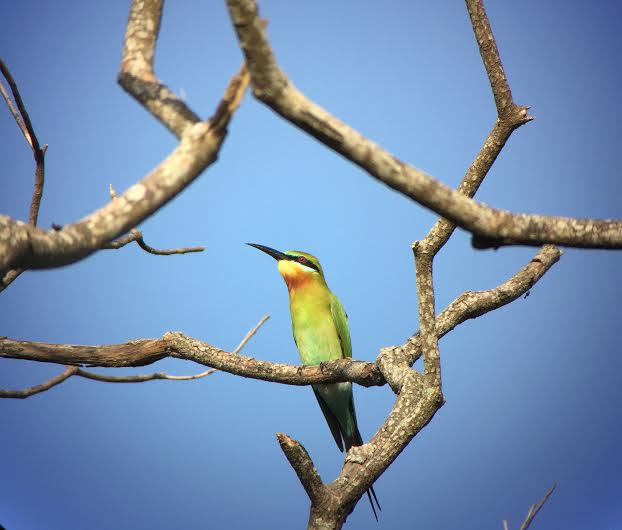
The very rare winter visitor Northern Pintail, male, at Sungei Buloh Wetland Reserve ( Photo: David Li)
We had a great start for the month with the surprised arrival of a Northern Pintail, Anas acuta, at Sungei Buloh. Mendis Tan reported a duck flying over Sungei Buloh in the morning of the 3rd and his colleague David Li found it in the evening. The last record was more than 23 years ago.Link
On the 13th, Alfred Chia was driving along the PIE when he saw two large woodpeckers flying across to the Mount Pleasant area. They were our long lost White-bellied Woodpeckers, Dryocopus javensis, co-incidentally last seen at the same area.
We also had a great ending for the month with the sighting of two Cinnamon-headed Pigeons, Treron fulvicollis, at Tampines Eco Green by Terry Chen on the 24th. They were foraging on the red berries of the Salam tree. A great Ang Pow Lifer for most of us. There were fewer than ten confirmed records of this non-breeding visitor, the last was at Pulau Ubin in 2011. Link. The other rare sighting was an Oriental Darter, Anhinga melanogaster, reported by Nicholas Tan on 6th over at Gombak Forest.
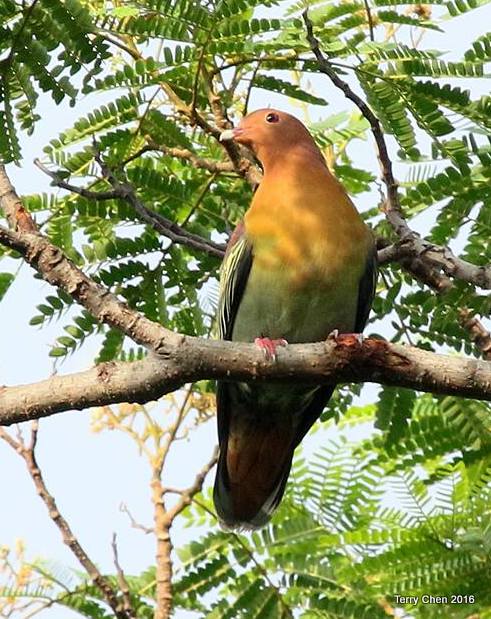
Terry Chen’s photo of the Cinnamon-headed Pigeon turned the quiet Tampines Eco Green into a mecca for birders and photographers.
Most of the action for February was centered again at Gardens by the Bay and the re-opened Kranji Marshes. The uncommon Common Moorhen, Gallinula chloropus, made a brief appearance at SBTB on 5th (Laurence Eu) followed by sightings of a Greater Coucal, Centropus sinensis, a forest edge species on the 8th ( Saravanan Krishnamurthy, Lim Ser Chai and Arman AF). The closest record was at Labrador and Mount Faber.
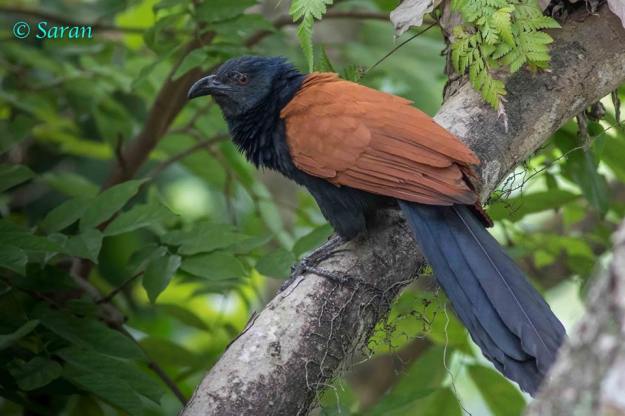
A surprise find of a forest-edge Greater Coucal at the SBTB on first day of CNY. Photo. Saravanan Krishnamurthy.
Francis Yap photographed a Black-crowned Night Heron, Nycticorax nycticorax, flying over the Gardens on 16th ( Anish Banerjee reported seeing one over the Barrage last month). A far away shot of a female Japanese Sparrowhawk, Accipiter gularis, by Cindy Yeo on 20th caused a stir when it was thought to be an Eurasian Sparrowhawk. Most of these birds are new for the Gardens.
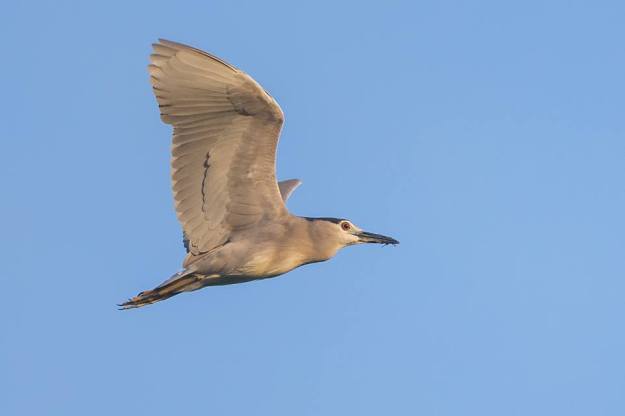
A Black-crowned Night Heron flying over the GBTB beautifully captured by Francis Yap.
Even though the core area of the Kranji Marshes were not accessible to the public, there were still plenty to see along the old NTL2 to the Raptor Tower. Lena Chow got the super sulking Lanceolated Warbler, Locustella lanceolata, near the tower on 5th. Wong Chung Cheong, Lawrence Cher and a few others got lucky with great photos of this uncommon warbler later on 13th at the same place.
Super sulker, Lanceolated Warbler at Kranji Marshes. 5th on left by Lena Chow and 13th on the right by Wong Chung Cheong.
A Sunda Scops Owl, Otus lempiji, was nearly run over along NTL2, but was spotted in time by Arjun Sai Krishnan on 8th. The open site next to the marshes attracted several shorebirds that prefer fresh water patches. A Long-toed Stint, Calidris subminuta, was reported by David Li on the 9th ( Adrian Silas Tay managed to photograph them on the 13th). Two Wood Sandpipers, Tringa glareola, were photographed there on 15th by Frankie Cheong. A female Yellow-rumped Flycatcher, Ficedula zanthopygia, was spotted by Koh Lian Heng on the 18th along NTL2 on its spring migration. We are happy to see the resident Blue-eared Kingfishers, Alcedo meninting, returning to the canal. Lawrence Cher photographed one on 27th.

The Blue-eared Kingfisher returned to its favourite hunting ground at Kranji. Photo: Lawrence Cher.
Two species of wagtails were also making their stop over on their way north. A Forest Wagtail, Dendronanthus indicus, at SBWR on 2nd (James Tann), a Grey Wagtail, Motacilla cinerea, was at the Masjid Hang Jabat canal on the 3rd ( Marcus Ng), and another at Bishan Canal on 10th (Lim Jit Yin). Other stopover migrants of note were a Von Schrenck’s Bittern, Ixobrychus eurthythmus, reported at the Serangoon Ave 3 Condo on 10th by Joe Lim, Yellow-browed Warbler, Phylloscopus inornatus,at the BTNR summit on 14th (Lim Kim Chuah). Some of the pond herons are assuming their breeding plumage. A Chinese Pond Heron , Ardeola bacchus, was photographed by James Tann over at the Chinese Gardens on 17th, another at Seletar on the 20th by Zacc HD, a Large Hawk Cuckoo , Hierococcyx sparverioides, at Halus Farmway 3 (Lim Kim Keang), a Blue-winged Pitta, Pitta moluccenis, at Rifle Range Link on 26th (David Tan) and a Hogdson’s Hawk Cuckoo, Hierococcyx nisicolor, back to Bidadari on 26th photographed by Frankie Lim.
Residents were more active and vocal this month as most were out looking for a mate. Grey-rumped Treeswifts, Hemiprocne longipennis,were seen flying over the HDB heartland of Mei Chin Road on 3rd (Marcus Ng), and over Mount Faber on 18th (Alan OwYong). A calling Rusty-breasted Cuckoo, Cacomantis sepulcralis, at Mount Faber on 6th ( Alan OwYong) first for this location, a Violet Cuckoo, Chrysococcyx xanthorthynchus, back feeding on the caterpillars at the JEG on 12th ( Lawrence Cher), the rare Yellow-vented Flowerpecker, Dicaeum chrysorrheum, at the BTNR summit on 14th (Lim Kim Chuah), Thick-billed Pigeon, Treron curvirostra, new to TEG on 18th (Ananth Ramasamy), a Great-billed Heron, Ardea sumatrana, seen over at Siloso heads at Sentosa on 20th (Ang Hock Chuah) and later across at Belayer Creek 3 days later ( Wolfe Repass) and a Black-headed Bulbul, Pycnonotus atriceps, at the edge of Sime Forest on 23rd by Lawrence Cher.

Brahminy Starling at Punggol Barat, an escapee? Photo: Francis Yap.
Just one non-breeding passserine visitor was reported this month. A Streaked Bulbul, Ixos malaccensis, on 14th at the summit at BTNR (Lim Kim Chuah). Francis Yap photographed a Brahminy Starling, Sturnus pagodarum, at Punggol Barat on the 8th. We had only one record of this out of range starling in 2008. It was listed under Category E for suspected released or escaped birds. This species was accepted into the Malaysian Checklist recently.
On the waders front, Grey Plovers, Pluvialis squatarola, were reported wintering at Pulau Semakau on 8th (Andy Dinesh) and more than 20 birds over at Seduku off P. Ubin on 11 reported by Daniel Ong. He also reported 4 Black-tailed Godwits, Limosa lomosa, one in breeding plumage at the same place and day.

Hovering Common Kestrel over Punggol Barat. Photo: Joseph Tan.
Our resident raptors were busy again raising their offsprings this month. Both the Changeable Hawk Eagles, Nisaetus cirrhatus, and the Crested Goshawk, Accipiter trivirgatus, have been seen feeding their chicks in the southern part of Singapore. A male Common Kestrel, Falco tinnunculus, was seen hunting over Punggol Barat on 23rd (Joseph Tan) and two Crested Serpent Eagles, Spilornis cheela, seen at NTL2 on 24th (Nicholas Tan) and an old haunt at Goldhill Avenue on 28th by Low Choon How.
Reference:
Lim Kim Seng. The Avifauna of Singapore. 2009 Nature Society (Singapore)
Yong Ding Li, Lim Kim Chuah and Lee Tiah Khee. A Naturalist’s Guide to the Birds of Singapore. 2013. John Beaufoy Publishing Limited.
This report is compiled by Alan OwYong and edited by Tan Gim Cheong from the postings in various facebook birding pages, bird forums and individual reports. Some were not verified. We wish to thank all the contributors for their records. Many thanks to David Li, Terry Chen, Lena Chow, Wong Chung Cheong, Joseph Tan, Francis Yap, Lawrence Cher and Saravanan Krishnamurthy for the use of their photos.
NTL2 – Neo Tiew Lane 2, SBWR – Sungei Buloh Wetland Reserves, JEG – Jurong Eco Gardens, BTNR – Bukit Timah Nature Reserve, PIE – Pan Island Expressway, SBTB– Satay by the Bay.
